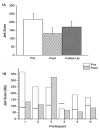Home-based telerehabilitation shows improved upper limb function in adults with chronic stroke: a pilot study
- PMID: 23319181
- PMCID: PMC4104503
- DOI: 10.2340/16501977-1115
Home-based telerehabilitation shows improved upper limb function in adults with chronic stroke: a pilot study
Abstract
Objective: This pilot study investigates the use of telerehabilitation to improve upper limb performance in chronic stages of stroke recovery.
Design: Intervention study with pre/post/one month follow-up tests.
Methods: Seven adults with chronic stroke participated in the study. Tests consisted of lab-based clinical and kinematic assessments. Participants completed the Upper Limb Training and Assessment (ULTrA) program at home. Training was 5 days/week, 60 min/day for 6 weeks with intermittent supervision of participants.
Results: Participants showed improvements in the training program tasks as well as clinical and kinematic assessments. Results also suggest there may be auxiliary benefits in cognitive function.
Conclusions: A home-based telerehabilitation program is a viable approach to provide rehabilitation in chronic stages of stroke.
Figures


References
-
- Lange B, Flynn SM, Rizzo AA. Game-based telerehabilitation. Eur J Phys Rehabil Med. 2009;45:143–151. - PubMed
-
- Demaerschalk BM. Telestrokologists: treating stroke patients here, there, and everywhere with telemedicine. Semin Neurol. 2010;30:477–491. - PubMed
-
- Brown SH, Lewis CA, McCarthy JM, Doyle ST, Hurvitz EA. The effects of Internet-based home training on upper limb function in adults with cerebral palsy. Neurorehabil Neural Repair. 2010;24:575–583. - PubMed
-
- Taub E, Uswatte G, Elbert T. New treatments in neurorehabilitation founded on basic research. Nat Rev Neurosci. 2002;3:228–236. - PubMed
-
- Paolucci S, Grasso MG, Antonucci G, Bragoni M, Troisi E, Morelli D, et al. Mobility status after inpatient stroke rehabilitation: 1-year follow-up and prognostic factors. Arch Phys Med Rehabil. 2001;82:2–8. - PubMed
Publication types
MeSH terms
Grants and funding
LinkOut - more resources
Full Text Sources
Other Literature Sources
Medical
Miscellaneous

